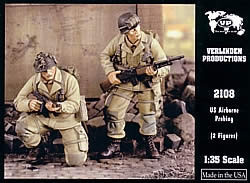| U.S.
Airborne Probing |
 |
|
This set carries a couple fundamental problems that will vex modelers looking to employ these paratroopers in dioramas. First, according to airborne historian Mark Bando, neither the 101st nor the 82nd Airborne had Browning Automatic Rifles when they assaulted Normandy, ostensibly the setting for these figures in their M1942 jump uniforms. So either the VP sculptor ignored accuracy in favor of simply designing a figure around the often-used molding of a right hand clasped onto a BAR, or he assumes you already know this fact and will opt to use this figure in a post-Market Garden setting, when the BAR was used by airborne. Or the sculptor assumes you will decide this figure picked up the weapon and the M1937 magazine belt from an infantry soldier who landed on the beach, made his way in country, and no longer needed them. Frankly, I'm assuming the sculptor didn't know what he was doing, since research and accuracy have not been the strongest attributes of the Verlinden organization. The other problem is scale height. The standing soldier is under 6', relatively short as far as Verlinden figures go but much more accurate in terms of historical height of American soldiers and more in line with other 1/35 scale figures. The kneeling soldier, however, is closer to 7'6" (measuring with a thread from heel through the joints up to the top of the helmet). It's not as noticeable since he is kneeling, but from the standpoint of bulk, he appears larger than true 1/35 scale figures from Nemrod and DML. This is also a problem with the preceding set of VP paratroopers, "Incoming!" (#2106), which also presents us with 7'+ giants. There's not much you can do to correct either of these figures' problems. The BAR gunner's distinctive magazine belt could be ground off, the pouches replaced with some suitable for Garand cartridges, but then you need to deal with find a couple hands to fit to the cuffs and convincingly hold a Garand. And then do you use an accurately scaled Garand, or Verlinden's knockoff of the 1/32 Airfix weapon? Another accuracy problem lies with the magazine pouch for the kneeling figure with the Thompson submachine gun. It's clear by the magazine on the gun that it is the shorter 20-round style. His pouch, which is bent as if empty, is sized for three short magazines. But I was unable to find in the four references I checked any such item. The 20-round magazines were carried in a five-slot pouch. The three magazine pouch was designed for the longer 30-round magazines. Finally, these figures do not wear the M1942 jump jackets, as the box art implies by the tan color of the jackets and trousers. Actually, the unidentified sculptor has fashioned M1943 OD jackets. I was fooled by the box art at first, but further examination shows the one-button arrow tab on sleeve cuffs, no pleated front hip pockets, and a larger cut lapel—all hallmarks of the M1943 jacket that was introduced to airborne soldiers for Operation Market Garden in September, 1944. So, if you want to use these figures in Normandy, as the box art suggests, you need to make some alterations to the jackets, the most difficult of which will be fixing the lapels. Verlinden has often had problems with accuracy throughout his product line, but this seems to reach a new low. If he and his team can't get a simple uniform correct, what does that suggest for other VP products? What is worse—ineptitude, or a con job? Also note that while the box art shows the reinforced knees in a greener canvas cloth, this is again a trick of painting and not sculpted into the figures themselves, as the patches are with figures from other manufacturers. Not all troopers had their uniforms reinforced, so you can opt not to depict them this way. As
with VP's usual inclusion of standard gear, you also get the nearly
standard dose of disappointment and frustration. -tss- |
 |
 |
 |
 |
 |
 |
 |
 |
 |
 |
 |
 |
|
 Verlinden
Productions
Verlinden
Productions